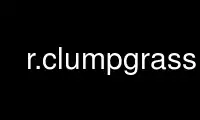
This is the command r.clumpgrass that can be run in the OnWorks free hosting provider using one of our multiple free online workstations such as Ubuntu Online, Fedora Online, Windows online emulator or MAC OS online emulator
PROGRAM:
NAME
r.clump - Recategorizes data in a raster map by grouping cells that form physically
discrete areas into unique categories.
KEYWORDS
raster, statistics, reclass, clumps
SYNOPSIS
r.clump
r.clump --help
r.clump [-dg] input=name [output=name] [title=string] [--overwrite] [--help]
[--verbose] [--quiet] [--ui]
Flags:
-d
Clump also diagonal cells
Clumps are also traced along diagonal neighboring cells
-g
Print only the number of clumps in shell script style
--overwrite
Allow output files to overwrite existing files
--help
Print usage summary
--verbose
Verbose module output
--quiet
Quiet module output
--ui
Force launching GUI dialog
Parameters:
input=name [required]
Name of input raster map
output=name
Name for output raster map
title=string
Title for output raster map
DESCRIPTION
r.clump finds all areas of contiguous cell category values in the input raster map. NULL
values in the input are ignored. It assigns a unique category value to each such area
("clump") in the resulting output raster map.
Category distinctions in the input raster map are preserved. This means that if distinct
category values are adjacent, they will NOT be clumped together. The user can run
r.reclass prior to r.clump to recategorize cells and reassign cell category values.
NOTES
By default, the resulting clumps are connected only by their four direct neighbors (left,
right, top, bottom). The -d flag activates also diagonal clump tracing.
r.clump works properly with raster map that contains only "fat" areas (more than a single
cell in width). Linear elements (lines that are a single cell wide) may or may not be
clumped together depending on the direction of the line - horizontal and vertical lines of
cells are considered to be contiguous, but diagonal lines of cells are not considered to
be contiguous and are broken up into separate clumps unless the -d flag is used.
A random color table and other support files are generated for the output raster map.
EXAMPLES
Perform clumping on "lakes" map (North Carolina sample dataset) and report area sizes for
each lake individually rather by waterbody type:
g.region raster=lakes -p
# report sizes by waterbody type
r.report lakes units=h
# clump per raster polygon
r.clump lakes out=lakes_individual
# report sizes by individual waterbody
r.report lakes_individual units=h
Use r.clumpgrass online using onworks.net services
